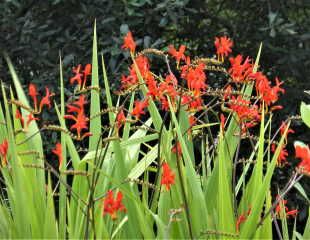
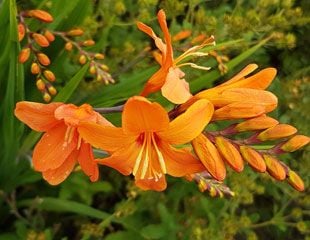
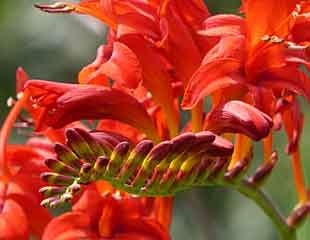
How To Grow Crocosmia
Crocosmia is an easy to grow herbaceous perennial. It flowers from early to late summer in strong shades of red, orange and yellow. It is a reliable border plant returning each year with lovely bold flowers in strong colours. Crocosmia is herbaceous, which means it dies back over the winter to bare earth, regrowing each spring. Crocosmia forms clumps with attractive, sword-shaped leaves and flowers for a long time.
Crocosmia originates from South Africa and has flowers in all the sunrise colours with much variation in height; varieties such as Jackanapes, and Canary Bird can be as small as 60cms (24") compared with Lucifer and Columbus which grow to 120 cm (48".) Height can be an important factor where to place plants in the border.
Crocosmia is so easy to grow it can be considered vigorous, if not invasive. Once established, it's often necessary to check growth to keep it reasonably contained in the border. Initially, pull up and remove any unwanted spread. The plant's corm (root) lies close to the surface, making it easy to remove. After a few years, it may be necessary to dig out around the plant to thin it each year to stop it taking over. In the autumn I dig out, or pull out by hand, around the edge of the patch of the Crocosmia to make an obvious demarkation line between it and the surrounding plants so it does not swamp them.
Crocosmia Lucifer, illustrated in the left and right images, looks magnificent, and is a tall architectural plant. Stake it, or it will flop all over the border, and most varieties need support.
Also, some specialist varieties, often seen at plant fairs and shows, are attractive, but unfortunately they may not be fully hardy. (explanation of frost hardy)
Crocosmia also makes great cut flowers and as the clumps produce so many blooms there is plenty for the garden and the vase. See image below.
How to Plant Crocosmia
Ideally, plant Crocosmia in a spot which is not too dry with plenty of sun. That said, Crocosmia is one of the tough perennials which will tolerate a wide range of conditions. Very dry soil may reduce flowering. The cheapest way to grow Crocosmia is from corms, compared to buying as garden ready plants. Crocosmia is easy to get going from corms and flower reliably.
Crocosmia corms are similar to bulbs and the best time to plant is early spring, so they hydrate in the early spring rain. Once hydrated, Crocosmia will grow as soon as the soil warms up in early spring. Plant Crocosmia corms about 8-10 cm (3-4") deep below soil level in a group to form a clump. Crocosmia is pest free and provides excellent colour to the borders. Crocosmia were formerly known as Montbretia and may occasionally still be referred to by this name.
You do not need to prune Crocosmia. As a herbaceous perennial in late autumn, the top growth will disintegrate, and dieback, leaving bare earth until spring, when fresh shoots will appear.
How to Stake Crocosmia
Crocosmia, if left unchecked, flops over, and lies over adjacent plants. It is not a good neighbour and to make it behave, it needs to be staked to make it grow more upright and contain it. This is particularly so of the taller varieties such as C. Lucifer which reaches 1.6m it will not stay upright without support.
In the image I have used Cornus stems (cut off in the late winter,) to make a loop. You could use stakes and string. For the taller varieties will need longer stakes and at least two rows of string. The advantage of a ring support such as this is you can move it upwards when the plant grows to provide greater support.


Crocosmia is a green wheelbarrow plant, being easy to grow and low maintenance
Planting combinations for Crocosmia
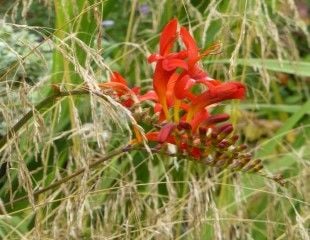
Crocosmia mixes well with grasses and, if possible, it's best to mix taller grasses with taller Crocosmia. For a bright combination, Crocosmia also looks good with blue Agapanthus, a tall combination for the back of a border. If you are growing Agapanthus in containers, you can place the container in the border next to the Crocosmia for the same effect.
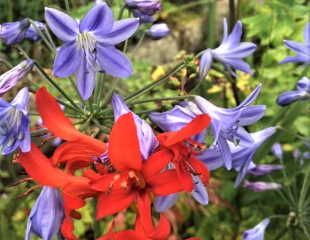

Crocosmia Lucifer Growing in Border
Here is Crocosmia Lucifer growing in a border, making a bold splash of red. I took this image at a National Garden Scheme Open Garden, Stoke Albany House.
The National Garden Scheme opens gardens, big and small, all over the country raising money for cancer and nursing charities. I love visiting one of the NGS gardens. Besides having a great day out, I always find planting ideas, great cake and it supports our national charities.
Crocosmia in mixed border
Crocosmia growing in a mixed border, looking lovely with the late flowering Allium sphaerocephalon and the faded seed heads of Thalictrum.
Good varieties of Crocosmia to grow
Many crocosmias listed here are fully hardy, which means you can plant and leave them in the borders over winter. The illustration above shows C. Lucifer on the left and right. C. masoniorum 'Rowallane Yellow' is, as the name suggests, a lovely yellow variety up to 80cms; both are good varieties which also have the RHS award of garden merit.
C.Lucifer is a very tall, striking variety growing up to 8m ( above right) and was developed in the 1960s by Alan Bloom of Bressingham Plants who was so prominent in the plant world and his family continues the tradition. He developed C. `Bressingham Blaze', a fine red, and C.`Spitfire', an orange-red, the shorter C.`Vulcan' a bright red and C.`Emberglow' a paler orange. I like all 4 varieties and especially C. Lucifer which is so striking in a border.
All Crocosmia bloom in shades of red, yellow, orange and some blend the two, such as 'Jackanapes'. Most Crocosmia are fully hardy but not all, such as Jackanapes, so it is worth checking first, especially if your garden is more exposed. Crocosmia prefers to be planted in a sunny spot, but is tolerant of a range of conditions including heavier, wetter soils. They may flower less well in less ideal conditions.
Crocosmia is only one of many beautiful summer flowering plants and also ideas on summer planting combinations.
C. 'Carmine Brilliant'
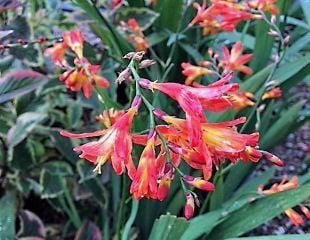
This is Crocosmia 'Carmine Brilliant' a lovely soft pink and yellow variety growing up to around 60cms. A good all rounder, not fussy about soil type, growing in sun or partial shade, sheltered or exposed spot with the RHS award of garden merit.
C. Jackanapes
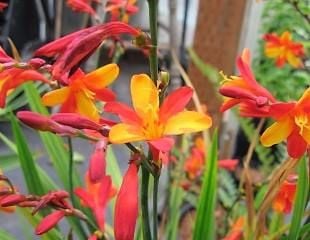
Another Crocosmia which is very easy to grow and tolerant of most conditions. It is an attractive bicoloured variety growing up to between .5 and 1 meter. It is quite hardy but not fully, only H5 requiring a sheltered spot or mulch in exposed areas.
Crocosmia as cut flowers
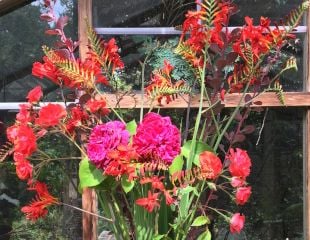
Crocosmia makes great cut flowers teamed here with red carnations and cerise roses with some berberis foliage. It's a really bold flower arrangement.
C.Lucifer as cut flowers

Red carnations and bronze foliage combine with Crocosmia Lucifer to create a late summer flower arrangement.
